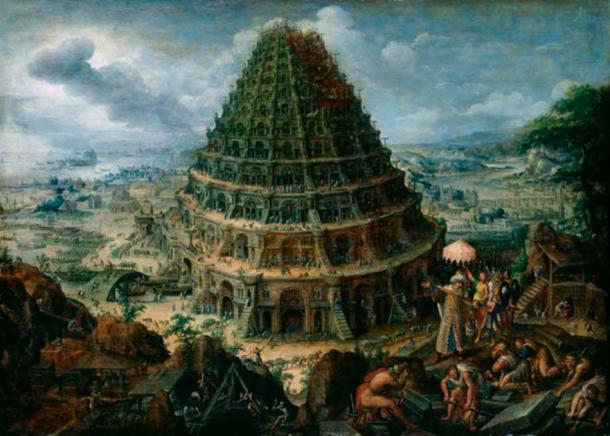Gateway to the Heavens: The Assyrian Account of the Tower of Babel
The story of the fabled Tower of Babel from the Book of Genesis has come to inspire artists throughout history and to symbolize the idea of human ambition. Once a real-life ziggurat at the center of the city of Babylon, this great tower was also mentioned within tablets excavated in modern-day Iraq.
The Biblical Story of the Tower of Babel
The story of the construction of a tower in Babel, which resulted in the confounding of language, has perplexed modern scholars for decades. The Book of Genesis tells of a time in which all of the world’s population migrated eastward to the plain of Shinar. Shinar, the Hebrew for “[land of the] two rivers,” is considered by most to be what the Akkadians referred to as Shumer or Sumer, known today as Mesopotamia, or modern-day Iraq.
- The Legendary Tower of Babel: What Does it Mean?
- The Qur’an and Torah on the True Meaning of the Tower of Babel and Multiple Languages
The Hebrew etymology is most likely referring to the rivers of the Tigris and Euphrates. In fear of being scattered across the whole face of the earth, the inhabitants of the plain decided to build a city and also a tower to reach the heavens. This city would be referred to as Babel (Akkadian: bab-ili or “gate of God”) which was also a play on the Hebrew word balal or “to confuse” (i.e. the language). According to the Old Testament, man was then punished for building this Tower of Babel through the creation of language, designed to create division amongst mankind.

The Tower of Babel by Pieter Brueghel the Elder. (Public domain)
Tower of Babel Excerpt within Genesis
The following excerpt is from the Jewish Publication Society translation of Genesis 11:
“1 And the whole earth was of one language and of one speech.
2 And it came to pass, as they journeyed east, that they found a plain in the land of Shinar; and they dwelt there.
3 And they said one to another: ‘Come, let us make brick, and burn them thoroughly.’ And they had brick for stone, and slime had they for mortar.
4 And they said: ‘Come, let us build us a city, and a tower, with its top in heaven, and let us make us a name; lest we be scattered abroad upon the face of the whole earth.’
5 And the Lord came down to see the city and the tower, which the children of men builded.
6 And the Lord said: ‘Behold, they are one people, and they have all one language; and this is what they begin to do; and now nothing will be withholden from them, which they purpose to do.
7 Come, let us go down, and there confound their language, that they may not understand one another’s speech.’
8 So the Lord scattered them abroad from thence upon the face of all the earth; and they left off to build the city.
9 Therefore was the name of it called Babel; because the Lord did there confound the language of all the earth; and from thence did the Lord scatter them abroad upon the face of all the earth.”

The Tower of Babel by Marten van Valckenborch the Elder. (Public domain)
Searching for the Tower of Babel: Excavating at Nineveh
While most of us are familiar with the Hebrew account of the dispersal of peoples and the introduction of new languages, archaeology has shown that the concept of a spreading of tongues is not as unique as we believe. We much divert our attention to George Smith, the very same George Smith who first translated the Epic of Gilgamesh in the 19th century, and provided the world with the earliest documented reference to the great flood.
Following his translation of Gilgamesh, Smith was sent to the site of Nineveh where he was to continue excavations in the hopes of unearthing additional inscriptions that paralleled or showed some relation to the Old Testament. Archaeology at the time was a new science, founded on validating the writings of the Bible.

George Smith was an English Assyriologist who excavated at Nineveh and found tablets with stories which may have inspired the Biblical account of the Tower of Babel. (Osama Shukir Muhammed Amin / CC BY-SA 4.0)
Discovery of Ancient Stories Which Inspired the Biblical Tower of Babel
Smith was fortunate, in that the excavation did yield additional tablets, from the Royal Library of Ashurbanipal, and upon further research he did actually discover a story likely to have inspired the Biblical account of the Tower of Babel. Catalogued and hidden in the inventory vaults of the British Museum, the fragmentary piece of text reads as follows:
“[…] them? The father […]
Of him, his heart was evil,
[…] against the father of all the gods was wicked,
[…] of him, his heart was evil,
[…] Babylon brought to subjection,
[small] and great he confounded their speech.
[…] Babylon brought to subjection,
[small] and great he confounded their speech.
Their strong place (tower) all the day they founded;
to their strong place in the night
entirely he made an end.In his anger also word thus he poured out:
[to] scatter abroad he set his face
he gave this? command, their counsel was confused
[…] the course he broke
[…] fixed the sanctuary”

Library of Ashurbanipal on display at the British Museum in London (Gary Todd / CC0)
George Smith provided a commentary to his translation briefly summarizing what the inscription meant to him, along with highlighting key words that emphasize the type of construction that took place.
“…we have the anger of the gods at the sin of the world, the place mentioned being Babylon. The building or work is called tazimat or tazimtu, a word meaning strong, and there is a curious relation, lines 9 to 11, that what they built in the day the god destroyed in the night.”
- Babelse Verwarring: The Confusion Around the Tower Of Babel Finally Solved
- Ancient Babylonian Tablet Provides Compelling Evidence that the Tower of Babel DID Exist
Key parallels are seen between the Biblical and Assyrian accounts, that is, that they both speak of mankind unified by a single language and building a tower, thus angering the gods, which resulted in the confusion of the language. The Assyrian account of the Tower of Babel, much like the other tablets found in the same collection, were most likely copies of older tablets. What inspired the Assyrian Babel and what was the original message conveyed? Much like its Hebrew counterpart, these questions continue to elude us.
Top image: The Tower of Babel. Source: Александр Михальчук / CC BY-SA 4.0
References
Davidson, B. 2004. The Analytical Hebrew and Chaldee Lexicon. 11th ed. Peabody: Hendrickson Publishers.
Koutoupis, P. 2008. Biblical Origins: An Adopted Legacy. College Station: Virtualbookworm.
No name. 2003. JPS Hebrew-English Tanakh. Philadelphia: Jewish Publication Society
Smith, G. 2005. The Chaldean Account of Genesis. London: Elibron Classics.


















Comments
After reading several of the comments I wanted to clarify that the Assyrian account wanted to kill the god who sent the flood.
in the biblical account Gilgamesh or referred to as Nimrod was a rebel against God and a mighty warrior.
The name Nimrod means to rebel against God.
As far as what I've seen of all the other ones with a similar biblical flood account the God who sent the flood was to kill the wicked.
The only one that differs from that is the story of Gilgamesh.
so I put those two together or all the other ones against the Gilgamesh retelling and you can see the perspective of what's being told.
Also Babylon is not referred to in the Bible is necessarily a location, but a particular type of empire. As Babylon is also existing or reemerging in prophecies that are yet fulfilled.
Rome was also considered one of these empires and when the stone was thrown at the feet made of clay and iron and destroyed it to never unite again it was the destruction of the Roman Empire. Jesus Christ was the stone that was not cut with human hands. Babylon reemerges and is destroyed in a day during the time of the Beast.
God was not angry at the people for building the tower of babel.
it was the technology or the ability of what they would be able to create if they stayed there they would quickly turn wicked again so they he had to separate them or they would quickly turn self-destructive and self dependent to repeat what he did that brought about the flood.
“And the LORD came down to see the city and the tower, which the children of men builded. And the LORD said, Behold, the people is one, and they have all one language; and this they begin to do: and now nothing will be restrained from them, which they have imagined to do. Go to, let us go down, and there confound their language, that they may not understand one another's speech. So the LORD scattered them abroad from thence upon the face of all the earth: and they left off to build the city. Therefore is the name of it called Babel; because the LORD did there confound the language of all the earth: and from thence did the LORD scatter them abroad upon the face of all the earth.”
Genesis 11:5-9 KJV
Not a KJV only.
when people lose dependency on God they become self-destructive and start bragging on themselves and or believe they are one. Plenty of history to say that.
Nimrod means rebell against God.
they didn't wanna scatter across the earth and God told him to scatter.
The scattering created the nations.
From there he chose a nation and not a strong one to show his power.
Please correct the article to show that it was not God’s anger that sent them but to save them.
Confusing their language slowed down this process.
as we can rapidly see what's happening as people are unifying on a global scale and it is self-destructive. Some benefits, but on the whole and the trajectory it's going is self-destructive.
thank you for considering.
In the biblical story of the Tower of Babel they tell us that everyone spoke one language, I believe it was telepathy! The stories tell of people living for hundreds of years. Do to the electromagnetic fields created by hydrogen and the magnetic field lines that exist thousands of feet above our heads called plasma tubes, I believe that the ocean levels were lower and the plasma tubes surrounding the planet were lower as well. This would explain the “Gods “ visiting and the planets “heaven” on earth. The electromagnetic spectrum or field was in constant contact with the planet allowing you to live in a “perfect harmony” with the light or space time! The Tower of Babel would be needed to connect with the electromagnetic field lines or plasma tubes forced away from the surface of the earth by the rise of the oceans and the energy created by hydrogen. There would have been no ground to sky lightning in those days. This could also be related to Stonehenge!
Multiple reports of Bible stories confirm the Bible accounts.
Also, could it be that this catastrophc flood that is laid into almost 3000 different cultures and languages actually happened and that this is what truly killed off everything instead of just an ice age? If you had a global flood as told in the story of gilgamesh or even the chinese flood accounts mayan etc it would cause the earth to cool tremendously.I mean the fact that they have found hundreds of frozen alive animals with fresh vegitation in their mouths and digestive tracts would point towards something far quicker than a crazy climate change from a single volcano or meteor impact? Just speculating.
Pages